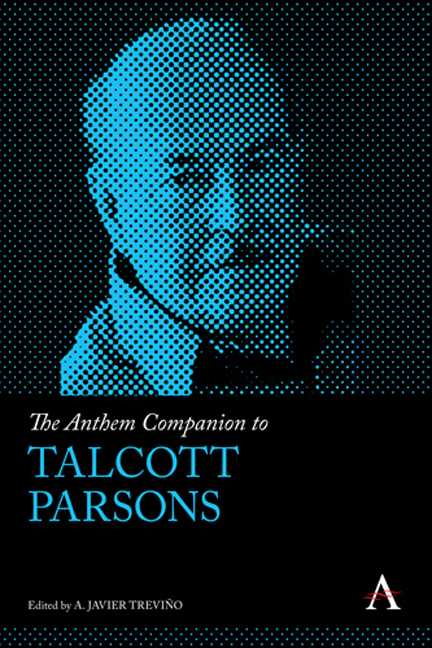Book contents
- Frontmatter
- Content
- Introduction
- Part I Political and Humanist Concerns
- Part II Social Evolution and the American Societal Community
- Chapter Seven Explaining Modernity: Talcott Parsons's Evolutionary Theory and Individualism
- Chapter Eight Talcott Parsons's Historical Analysis and the Cultural–Political Freeze in China: A Reinterpretation
- Chapter Nine Talcott Parsons and American Exceptionalism
- Chapter Ten American Society and the Societal Community: Talcott Parsons, Citizenship and Diversity
- Chapter Eleven Parsons and Nisbet: Two Versions of Sociological Communitarianism
- Contributors
- Index
Chapter Seven - Explaining Modernity: Talcott Parsons's Evolutionary Theory and Individualism
from Part II - Social Evolution and the American Societal Community
Published online by Cambridge University Press: 22 July 2017
- Frontmatter
- Content
- Introduction
- Part I Political and Humanist Concerns
- Part II Social Evolution and the American Societal Community
- Chapter Seven Explaining Modernity: Talcott Parsons's Evolutionary Theory and Individualism
- Chapter Eight Talcott Parsons's Historical Analysis and the Cultural–Political Freeze in China: A Reinterpretation
- Chapter Nine Talcott Parsons and American Exceptionalism
- Chapter Ten American Society and the Societal Community: Talcott Parsons, Citizenship and Diversity
- Chapter Eleven Parsons and Nisbet: Two Versions of Sociological Communitarianism
- Contributors
- Index
Summary
When Norbert Elias's Über den Prozess der Zivilization first appeared in 1939, Talcott Parsons—whose The Structure of Social Action had been published just a couple of years before—was pretty well unknown beyond the gates of Harvard Yard. Thirty years later, when his book was reissued to great acclaim, Elias could attack Parsons as “the leading theoretician of sociology”—a phrase that was more fitting as a hackneyed image of past times than as a current description. In his critique, Elias focused on Parsonian sociology as the epitome of a static, and strongly unrealistic, brand of analytical thinking. In reducing “social processes” to “social states,” Elias noted, Parsonian sociology proved to be singularly unable to describe, let alone explain, social change. Elias's attack was not surprising, as in the late 1960s, critiques about the inadequacy of the Parsonian paradigm for the study of social dynamics were common currency—with David Lockwood, Ralf Dahrendorf and Barrington Moore Jr. being the most vociferous critics of the primacy of “equilibrium” in Parsons's general sociological theory.
Some pages later, Elias criticized Parsons from another point of view; one that seemed more peculiar to those who knew of the American sociologist's enduring opposition to all kinds of empiricism and methodological individualism in the social sciences. According to Elias, the greatest failure of modern philosophical thought was its treatment of the individual and society as “two phenomena existing separately.” As a scientific attempt to “reconcile the idea of an absolutely independent and free individual with that of an equally independent and free ‘social totality,’” Parsons's sociological theory partook of the same philosophical notion. Elias accused Parsons of embracing the image of the individual as homo clausus, the entirely self-sufficient actor “cut off from all other beings and things,” put forward by such champions of modern contractualism as Thomas Hobbes and John Locke—whose fallacies, to be sure, Parsons had exposed in The Structure of Social Action 30 years before.
Puzzling as they may seem, Elias's critiques point to one of the most ill-understood aspects of Talcott Parsons's work: the relationship between his theory of social change and his understanding of modern society.
- Type
- Chapter
- Information
- The Anthem Companion to Talcott Parsons , pp. 133 - 154Publisher: Anthem PressPrint publication year: 2016



